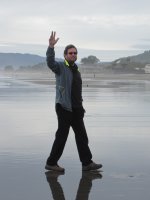
John Batchelder, Stage II
Diagnosed 02/01/2013
I am a 63-year-old Californian with a lot of Scottish, Irish, and English ancestry. I spent 20 years managing construction projects in the Sacramento area, which required me to spend a lot of time outside in the CA sun. Adding insult to my white freckled skin, I lived in Cali, Colombia, (near the equator) when I was in high school. I played on the high school basketball team. Our BBall team practiced outside in the afternoon equatorial sun every day. Of course, I took my shirt off during basketball practice to improve my tan and to help stay cool.
Fast forward to early February 2013. I had felt a new bump on the back of my neck when showering for a few weeks. I could not see the bump because it was mid-line just under the hairline on the back of my neck. I asked my wife to take a look at the bump and tell me what she saw. She told me that it looked like a ¼-inch diameter blood blister. My son looked at it, and he also thought it was a blood blister. He offered to use a pointed knife to drain the blood blister for me. I told my son to not touch the bump. I asked my wife to take some photos of the bump with my smart phone, so that I would have a better understanding of what was growing on the back of my neck.
I looked at the photo, and it did not look like a blood blister. It looked to me like living cells that were growing under my epidermis.
I was surfing the Internet on my laptop when my wife took the photo of the growth, so I Googled skin cancer and browsed some photos and descriptions of skin cancer. Within a few minutes I found myself staring at photos on a web page that were described as fatal cases of nodular melanoma cancer. Much to my shock, the bump on my neck looked exactly like one of the fatal nodular melanoma tumors.
I saw my general practitioner the next day and told him my concerns. My GP dismissed my concerns, but he referred me to a dermatologist for a second opinion. My medical group scheduler told me that it would take 1 month to see a dermatologist. Based upon what I had read on the skin cancer web page, I was under the impression that the growth should immediately be removed for biopsy if there was any possibility of it being melanoma.
Well, my adrenaline level prompted me to call my dermatologist several times every day for several days until the scheduler finally told me that I could see the dermatologist the next day if I was willing to drive 10 miles to another office.
I told the dermatologist my concerns. She said that at worst it was likely an odd amelanotic basal cell tumor and that she would remove it for biopsy. One week later, my dermatologist called me and breathlessly told me that I was correct in my evaluation of the tumor. It was a Stage IIA nodular melanoma tumor; 2.9 mm depth with biological activity, 3.9 mm depth including all structures, mitotic rate 3.
Two weeks later, I had lymphoscintigraphy followed by a sentinel lymph node biopsy and a wide local incision. My sentinel lymph nodes (one on the back of my neck and three on the left side of my neck) were all negative for melanoma. The skin from the WLE (2.5-inch margins with skin flap reconstruction) was also negative for melanoma.
Since the time of the surgery in early March 2013 I have had a brain MRI (June 2013) and a PET scan (January 2014) as well as semi-annual blood tests. I also had a PET scan last week, and I will meet with my oncologist tomorrow to discuss the PET scan results. So far, I have exhibited no signs of recurrence.
My oncology PA who works with my oncologist told me last month that MD Anderson has Stage IIA patients have chest x-rays every 3 months for the first 2 years. Their experience is that Stage IIA melanoma patients typically experience mets to their lungs before it spreads to other organs. I wish my oncologist had ordered chest x-rays for me every 3 months. I will learn tomorrow if my PET scan shows any mets.
I will update this web site after my oncology appointment tomorrow 01.20.2015.
One reason that I wanted to share my story is that it has been so helpful to me in the past 2 years to read other melanoma patients’ stories, especially the Stage IV patients who have successfully battled melanoma for many years. Thank you for sharing your very personal stories with other melanoma patients.
Copyright © 2014-2022 - AIM at Melanoma Foundation. All rights reserved. Website by RED ZEPHYR DESIGN

